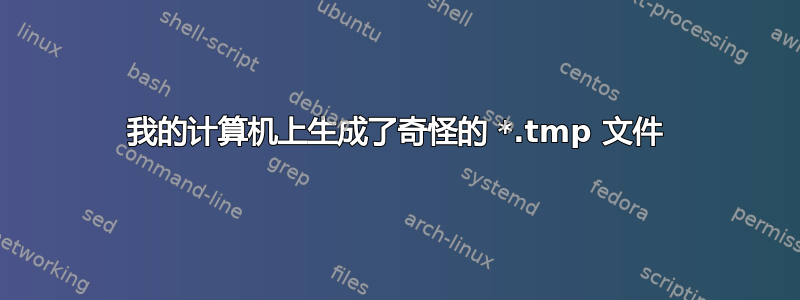
最近我发现我的 c:\temp 目录下自动生成了大量 *.tmp 文件。文件名如下:
FLT1A00.tmp
FLT1A5.tmp
...
FLT3EF3.tmp
该文件内容与boost库相关:
//
// signal_set.cpp
// ~~~~~~~~~~~~~~
//
// Copyright (c) 2003-2011 Christopher M. Kohlhoff (chris at kohlhoff dot com)
//
// Distributed under the Boost Software License, Version 1.0. (See accompanying
// file LICENSE_1_0.txt or copy at http://www.boost.org/LICENSE_1_0.txt)
//
// Disable autolinking for unit tests.
#if !defined(BOOST_ALL_NO_LIB)
#define BOOST_ALL_NO_LIB 1
#endif // !defined(BOOST_ALL_NO_LIB)
// Test that header file is self-contained.
#include <boost/asio/signal_set.hpp>
#include <boost/asio/io_service.hpp>
#include "unit_test.hpp"
//------------------------------------------------------------------------------
// signal_set_compile test
// ~~~~~~~~~~~~~~~~~~~~~~~
// The following test checks that all public member functions on the class
// signal_set compile and link correctly. Runtime failures are ignored.
namespace signal_set_compile {
void signal_handler(const boost::system::error_code&, int)
{
}
void test()
{
using namespace boost::asio;
try
{
io_service ios;
boost::system::error_code ec;
// basic_signal_set constructors.
signal_set set1(ios);
signal_set set2(ios, 1);
signal_set set3(ios, 1, 2);
signal_set set4(ios, 1, 2, 3);
// basic_io_object functions.
io_service& ios_ref = set1.get_io_service();
(void)ios_ref;
// basic_signal_set functions.
set1.add(1);
set1.add(1, ec);
set1.remove(1);
set1.remove(1, ec);
set1.clear();
set1.clear(ec);
set1.cancel();
set1.cancel(ec);
set1.async_wait(&signal_handler);
}
catch (std::exception&)
{
}
}
} // namespace signal_set_compile
//------------------------------------------------------------------------------
test_suite* init_unit_test_suite(int, char*[])
{
test_suite* test = BOOST_TEST_SUITE("signal_set");
test->add(BOOST_TEST_CASE(&signal_set_compile::test));
return test;
}
有人知道问题是什么吗?
谢谢
答案1
您没有说明它到底是什么操作系统。网络搜索显示,这一特定事件是通过与 Office 2010 相关的“索引服务”发生的。 ms 答案链接 1 &msanswers 链接 2
要确定它是否是病毒,请禁用索引服务,或者在 win7 中禁用名为搜索的服务,然后查看它是否停止。(我怀疑这种情况的合法发生只是 XP 的事情)此外,使用资源监视器或进程资源管理器之类的程序,您可以找出哪个程序正在执行此操作。
Boost 的东西,对于上面的索引器来说毫无意义,相反,它看起来像是某个正在运行的程序,或者可能是病毒。哪个程序/进程正在创建文件是最重要的。
要测试索引器,请在管理工具中打开“计算机管理”,或compmgmt.msc /s在运行中输入查找名为“服务和应用程序”的部分,展开它,您将看到服务中的“服务”双击“索引服务”并将其(暂时)设置为禁用,然后点击左侧的停止按钮。
答案2
这种情况只发生过一次还是反复发生?你做过编程吗?你最近安装过任何程序吗?
您可以使用Windows 安全审核监视文件的创建和访问位置和时间。
您还可以使用进程监控设置文件过滤器来监视哪些进程创建/访问文件,包括在下次启动时:

答案3
病毒……嗯……你的防病毒软件怎么说?
我在那里找到了与该 tmp 文件相关的代码:
http://www.koders.com/cpp/fid024CECB842BD1FDCABCFD63C392C135FB873E597.aspx?s=thread
这与这个 Google 代码应用程序相关:
http://code.google.com/p/solwidget/
不是嗎?如果我是对的您的系统中正在运行此应用程序。如果您不信任它,您可以将程序上传到 VirusTotal 等...
希望这能有所帮助。让我们知道。:)


